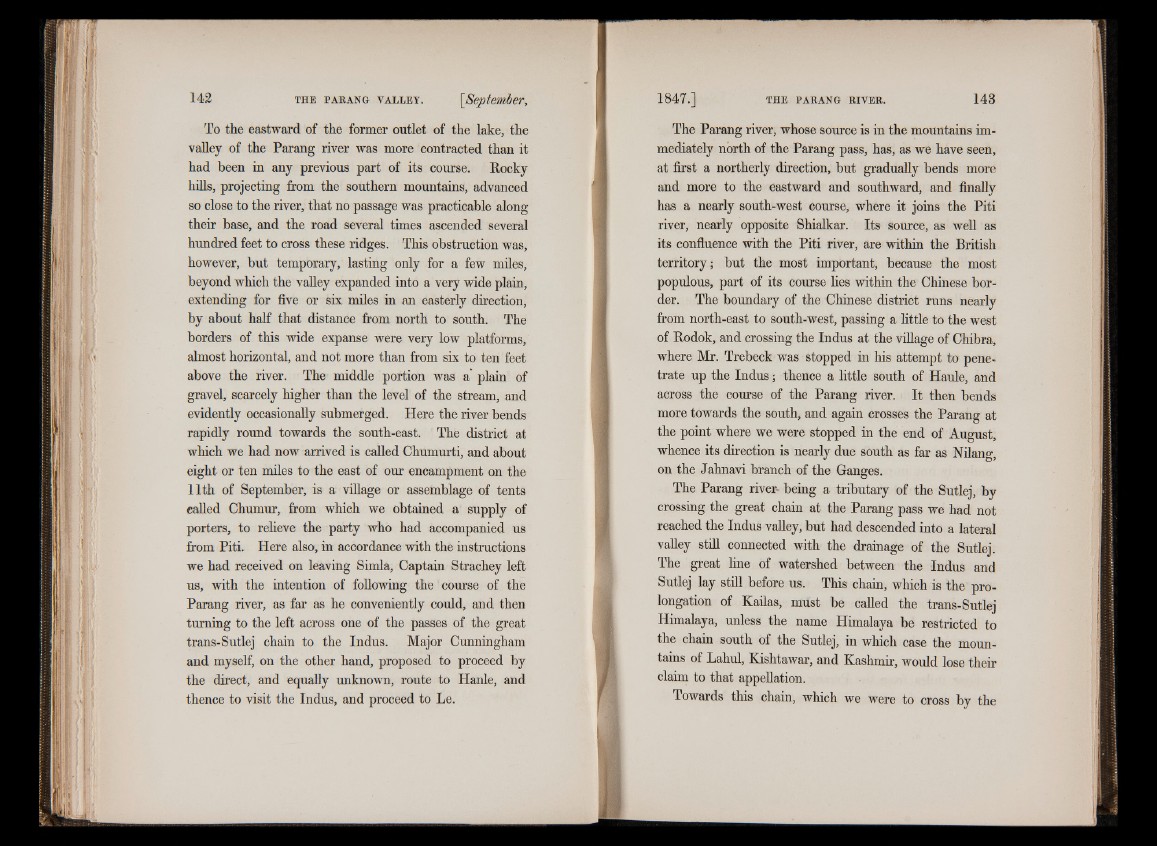
To the eastward of the former outlet of the lake, the
valley of the Parang river was more contracted than it
had been in any previous part of its course. Rocky
hills, projecting from the southern mountains, advanced
so close to the river, that no passage was practicable along
their base, and the road several times ascended several
hundred feet to cross these ridges. This obstruction was,
however, but temporary, lasting only for a few miles,
beyond which the valley expanded into a very wide plain,
extending for five or six miles in an easterly direction,
by about half that distance from north to south. The
borders of this wide expanse were very low platforms,
almost horizontal, and not more than from six to ten feet
above the river. The middle portion was a’ plain of
gravel, scarcely higher than the level of the stream, and
evidently occasionally submerged. Here the river bends
rapidly round towards the south-east. The district at
which we had now arrived is called Chumurti, and about
eight or ten miles to the east of our encampment on the
11th of September, is a village or assemblage of tents
sailed Chumur, from which we obtained a supply of
porters, to relieve the party who had accompanied us
from Piti. Here also, in accordance with the instructions
we had received on leaving Simla, Captain Strachey left
us, with the intention of following the course of the
Parang river, as far as he conveniently could, and then
turning to the left across one of the passes of the great
trans-Sutlej chain to the Indus. Major Cunningham
and myself, on the other hand, proposed to proceed by
the direct, and equally unknown, route to Hanle, and
thence to visit the Indus, and proceed to Le.
The Parang river, whose source is in the mountains immediately
north of the Parang pass, has, as we have seen,
at first a northerly direction, but gradually bends more
and more to the eastward and southward, and finally
has a nearly south-west course, where it joins the Piti
river, nearly opposite Shialkar. Its source, as well as
its confluence with the Piti river, are within the British
territory ; but the most important, because the most
populous, part of its course lies within the Chinese border.
The boundary of the Chinese district runs nearly
from north-east to south-west, passing a little to the west
of Rodok, and crossing the Indus at the village of Chibra,
where Mr. Trebeck was stopped in his attempt to penetrate
up the Indus; thence a little south of Haule, and
across the course of the Parang river. It then bends
more towards the south, and again crosses the Parang at
the point where we were stopped in the end of August,
whence its direction is nearly due south as far as Nilang,
on the Jahnavi branch of the Ganges.
The Parang river- being a tributary of the Sutlej, by
crossing the great chain at the Parang pass we had not
reached the Indus valley, but had descended into a lateral
valley still connected with the drainage of the Sutlej.
The great line of watershed between the Indus and
Sutlej lay still before us. This chain, which is the prolongation
of Kailas, must be called the trans-Sutlej
Himalaya, unless the name Himalaya be restricted to
the chain south of the Sutlej, in which case the mountains
of Lahul, Kishtawar, and Kashmir, would lose their
claim to that appellation.
Towards this chain, which we were to cross by the